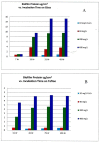Natural Pathogen Control Chemistry to Replace Toxic Treatment of Microbes and Biofilm in Cooling Towers
- PMID: 28420074
- PMCID: PMC5488648
- DOI: 10.3390/pathogens6020014
Natural Pathogen Control Chemistry to Replace Toxic Treatment of Microbes and Biofilm in Cooling Towers
Abstract
Application of toxic antibacterial agents is considered necessary to control prevalent fresh water microorganisms that grow in evaporative cooling water systems, but can adversely affect the environment and human health. However, natural antibacterial water chemistry has been applied in industrial cooling water systems for over 10 years to inhibit microorganisms with excellent results. The water chemistry method concentrates natural minerals in highly-softened water to produce elevated pH and dissolved solids, while maintaining low calcium and magnesium content. The method provides further benefits in water conservation, and generates a small volume of non-toxic natural salt concentrate for cost efficient separation and disposal if required. This report describes the antimicrobial effects of these chemistry modifications in the cooling water environment and the resultant collective inhibition of microbes, biofilm, and pathogen growth. This article also presents a novel perspective of parasitic microbiome functional relationships, including "Trojan Protozoans" and biofilms, and the function of polyvalent metal ions in the formation and inhibition of biofilms. Reducing global dependence on toxic antibacterial agents discharged to the environment is an emerging concern due to their impact on the natural microbiome, plants, animals and humans. Concurrently, scientists have concluded that discharge of antibacterial agents plays a key role in development of pathogen resistance to antimicrobials as well as antibiotics. Use of natural antibacterial chemistry can play a key role in managing the cooling water environment in a more ecologically sustainable manner.
Keywords: Legionella; amoeba; antibacterial; antimicrobial; biocides; biofilm; cooling towers; pathogens; polyvalent metals; protozoa.
Conflict of interest statement
The authors declare no conflicts of interest.
Figures










References
-
- Rahimian-Pour A., Anderson E. Legionella Outbreak Prevention. Analyst. 2016;23:38–43.
-
- Bartram J., Chartier Y., Lee J., Pound K., Surman-Lee S., editors. Legionella and Prevention of Legionellosis. World Health Organization; Geneva, Switzerland: 2007. [(accessed on 6 December 2016)]. p. 31. Available online: https://books.google.com/books?hl=en&lr=&id=rAoI8DzB7YgC&oi=fnd&pg=PT5&d....
-
- Jain P., Sinha S. Neurophiles: Acid Challenge and Comparison with Acidophiles. Internet J. Microbiol. 2008;7 doi: 10.5580/1ee7. - DOI
-
- Lengeler J., Drews G., Schlegel H. Biology of the Prokaryotes. John Wiley & Sons; Hoboken, NJ, USA: 2009. pp. 662–663.
-
- Department of Ecology-State of Washington ECOconnect, Let’s Talk Science, a pH Solution. [(accessed on 6 December 2016)]; Available online: http://ecologywa.blogspot.com/2014/02/lets-talk-science-ph-solution.html.
Publication types
LinkOut - more resources
Full Text Sources
Other Literature Sources

